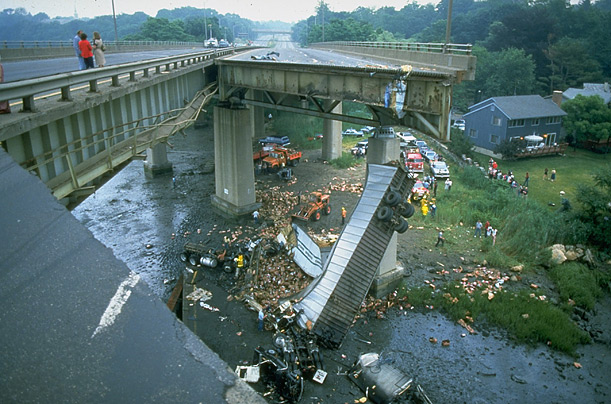Mianus River Bridge Collapse

photo credit: Hank Morgan / Time Life Pictures / Getty
accesed from the Time photo gallery here.
Location
The Mianus bridge supported the six-lane Interstate 95 where it crossed the Mianus River near Greenwich, Connecticut. You can see a satellite image of the bridge from Google Maps here: Mianus River Bridge. The latitude and longitude of the bridge are 41.0344670 and -73.5957600. You can learn more about the Mianus River on Wikipedia here.
History
The bridge was built in 1958 and collapsed in 1983, after 25 years of use. The Mianus River bridge used a "pin and hanger" design common to 1950's era bridges (2). Pin and hanger designs had cheaper construction costs compared to other design options (2). A historic overview of the Connecticut Turnpike, "The Mianus River Bridge and its Legacy" can be visited here.
Details of the Collapse
On June 28, 1983, at 1:30AM, a 100 foot suspended span of the northbound section of the bridge collapsed, completely separating from the bridge and falling into the river (see photo above). Two tractor-trailers and two cars fell into the Mianus River. There were three deaths and three serious injuries.
About the bridge design
The Mianus Bridge used skewed simple spans, supported on the outer edges by longitudinal girders, and by six piers (4). Each span weighed 500 tons. Skewed bridges cross at an angle rather than perpendicularly, and the spans were supported at each corner by pin and hanger assemblies.
Pin and hanger assemblies connect two plate girders when the space between piers is too long to be connected by a single set of girders (3). The hangers were held in place by thin locking caps. Pin and hanger assemblies are considered "fracture-critical" components. Fracture-critical components are non-redundant: failure of these components can lead to failure of part or all of a bridge. Because of their fracture-critical nature, pin and hanger assemblies are no longer used in the construction of United States bridges (6).
After the collapse, the missing hanger pin was found in the river below.
Sequence of Events and Cause of the Collapse
Ten years prior to the collapse, storm drains on the bridge were paved over during a resurfacing project. Without proper drainage, corrosion developed behind the locking caps, causing displacements of the pin and hanger assemblies (1). An inside hanger slipped off its pin and shifted the weight it was supporting to the sole outside hanger, doubling the load on the outer hanger. A fatigue crack developed in the pin supporting all the weight. The crack allowed a portion of the upper pin to separate from the pin. This caused the hanger to slip off the upper pin and the span failure followed.
After the failure, the load-bearing surface of the inside hanger and the inside end of the lower pin were found to be severely corroded, and part of the bottom edge of the pin had broken off. The failure was determined to be the result of a progressive process occurring over time and leading to extensive corrosion which was responsible for the hanger displacement and collapse (1).
While the collapse was technically due to the failure of a pin and hanger assembly, the state of Connecticut was faulted for inadequate inspections. When the bridge collapsed, there were twelve inspectors working in pairs to inspect 3,425 bridges in Connecticut (5). Additionally, some state supervisors did not distribute new federal regulatory guidelines to state maintenance inspectors which may have made them aware of problems relevant to the collapse (6).
Collapse Outcomes
The collapse occured despite the nationwide inspection procedures brought about by the collapse of the Silver Bridge. After the Mianus bridge collapse, inspectors and regulators realized that corrosion prevention must be maintained and inspected, critical elements of the bridge must be cleaned before inseption, and specialized equipment must be used to access critical areas (6).
During the repair of the bridge, the storm drains were reopened. Storm drains on similar bridges were also reopened. Inspections commenced to ensure the proper drainage and maintenance of drains. Retrofits were suggested and applied to the Mianus Bridge and other bridges including the Harvard Bridge across the Charles River to Boston.
References
1. McEvily, A. J. (2001). Metal Failures: Mechanisms, Analysis, Prevention. ISBN: 978-0-471-41436-0. Read an excerpt (pdf) on failure analysis here.
2. "The Mianus River Bridge and its Legacy" A Historic Overview of the Connecticut Turnpike, here.
3. Wikipedia: Pin and Hanger Assembly. Retrieved April 25, 2008.
4. Wikipedia: Mianus River Bridge. Retrieved April 25, 2008.
5. UPI (1984). The region; hartford faulted in bridge collapse. New York Times. Published May 25, 1984. Retrieved May 5, 2008.
6. Delatte, Norb. Maintenance and Management Lessons Learned from Bridge Collapses. Prepared for the Transportation Research Board Annual Meeting, 2007. Paper #07-2306. Abstract and retrieval information here.
Comments (0)
You don't have permission to comment on this page.